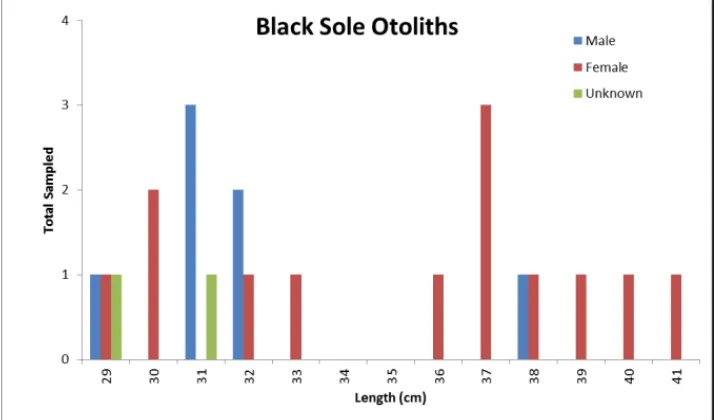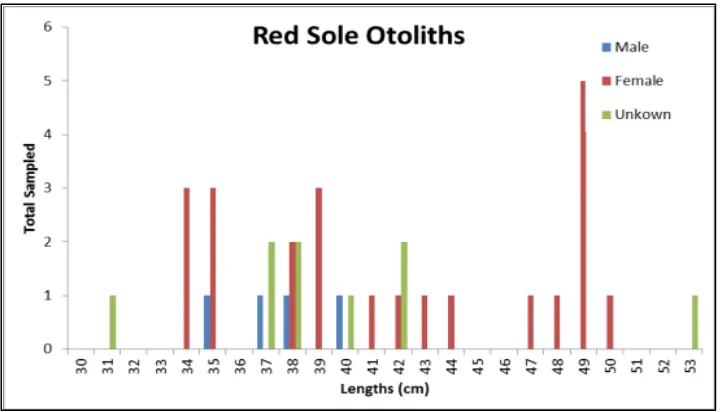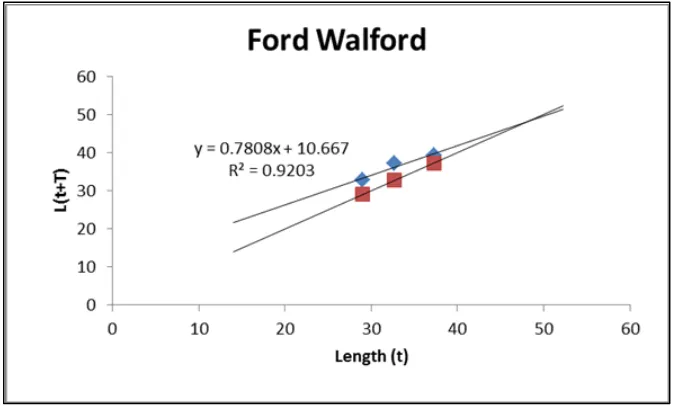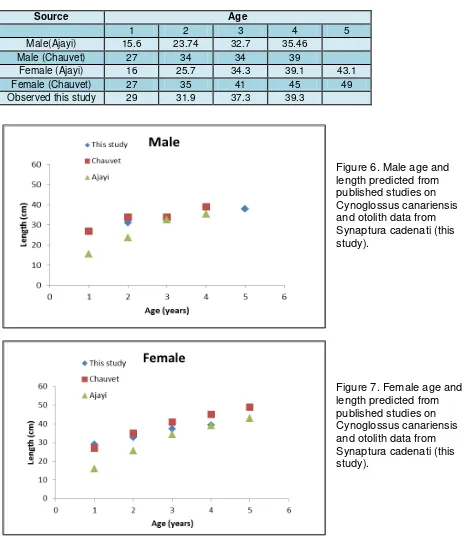Age Determination of the Black Sole, Synaptura
cadenati and the Red Sole, Cynoglossus
senegalensis
in The Gambia using Otoliths
Gambia-Senegal Sustainable Fisheries Project
(BaNafaa)
2011
This publication is available electronically on the Coastal Resources Center’s website at http://www.crc.uri.edu. For more information contact: Coastal Resources Center,
University of Rhode Island, Narragansett Bay Campus, South Ferry Road,
Narragansett, Rhode Island 02882, USA. Tel: 401) 874-6224; Fax: 401) 789-4670; Email: info@crc.uri.edu
The BaNafaa project is implemented by the Coastal Resources Center of the University of Rhode Island and the World Wide Fund for Nature-West Africa Marine Ecoregion (WWF-WAMER) in partnership with the Department of Fisheries and the Ministry of Fisheries, Water Resources and National Assembly Matters.
Citation: Gibril Gabis, Lamin Sanyang, Ivan Mateo, John Burnett and Kathleen Castro, 2011.Age Determination of the Black Sole, Synaptura cadenati and the Red Sole, Cynoglossus senegalensis in The Gambia using Otoliths, Coastal Resources Center, University of Rhode Island, pp.11
Disclaimer: This report was made possible by the generous support of the American people through the United States Agency for International Development (USAID). The contents are the responsibility of the authors and do not necessarily reflect the views of USAID or the United States Government. Cooperative Agreement # 624-A-00-09-00033-00.
Cover Photo: Detail Otolith (right and left pictures) and sole catch (center)
Acknowledgements
Table of Contents
Introduction ... 5
Methods ... 6
Results ... 7
Validation ... 10
Discussion ... 11
References ... 12
List of Figures Figure 1. Otoliths (left) extracted from sole atlanding site. Otoliths (right) extracted at AS ... 6
Figure 2. Detail Otolith extraction ... 6
Figure 3. Otolith samples from black sole by sex and size. ... 7
Figure 4. Otolith samples from red sole by sex and size. ... 8
Figure 5. Von Bertalanffy age growth model for black sole ... 9
Figure 6. Male age and length predicted on Cynoglossus canariensis ... 10
Introduction
The use of otoliths (ear stones) to determine age in fish is a well-tested method
frequently used in marine temperate water areas (AFS, 1983). Annual marks are easily distinguished because growth is seasonal. Fish are usually born in the same season and there are patterns of warm temperature and rapid growth and cooler temperature with reduced growth. The advantages of using otoliths for aging are that they are formed during the embryonic period and reflect all life history events. Growth bands correspond to daily, seasonal or annual patterns. The presence of distinguishable daily increments in otoliths provides an accurate and precise method for age estimation. The chemical properties of otoliths also provides a window to the past environmental
conditions that might allow a fish to be biopositioned in space and time throughout its life (Campana and Thorrold, 2000).
There is a misconception that tropical fish cannot be aged using this method because of the aseasonal environment. Fowler (1995) showed that tropical fish do have seasonal otolith increments and a recent review (Morales-Nin and Panfili, 2005) demonstrated that two main forcing variables influence the seasonal variations in the tropics:
temperature and hydrology. Sea surface temperatures reflect seasonal variations and upwelling events especially in the major coastal regions of the world (including West Africa). The different fish species in these environments generally have high specific growth rates with both K and r strategies leading to extremely variable longevities. All types of reproductive strategies exist in the tropics from pelagic egg spawning to small brood spawners. The most important variation in regards to aging fish is variable reproductive timing as the estimation of birth date may be difficult to calculate.
Seasonal growth variations are now recorded and validated in a wide range of tropical species. Annual increment interpretability varies between tropical species and between regions with the trend towards more difficulties with decreased temperature fluctuations (Caldow and Wellington, 2003). Care needs to be taken when examining the otoliths from tropical species especially in regards to the first growth area, birth date and reproductive cycle. Daily growth marks have been documented on several tropical species to date. Being able to age fish provides stock assessment scientists with an accurate tool to estimate growth and mortality. Recruitment, growth and mortality rates are three of the most important life history characteristics controlling the productivity of fish populations.
Methods
Otoliths were collected from sole captured by the artisanal fishery in Brufut and
processed at the Atlantic Seafood facility and from directly from sole landed in Sanyang. An attempt was made to sample fish from a wide range of sizes in order to collect fish from as many different age classes as possible. Fish were measured, then both otoliths were removed, and the fish sex and maturity were recorded.
Figure 1. (Left picture) Otoliths extracted from sole at beach landing site.(Right picture) Otoliths extracted at Atlantic Seafood
Cuts were made just above the cranium in order to open up the cranial cavity. Tweezers were then used to locate and remove the two otoliths. Once removed, the otoliths were cleaned, dried and placed directly into labeled envelopes. All otoliths were stored in manila coin envelopes and labeled with date, species, landing site, length and sex. Males were identified by the presence of the testis; presence of ovary or eggs for the females. Immature fish were generally unclassified.
Figure 2. Detail Otolith extraction
Growth is described by the Von Bertalanffy growth model (1938), a simple asymptotic function that is calculated as:
Where L∞ is asymptotic length (the value of L for which growth is zero), t is age, K is the growth coefficient.
Parameters for the model were calculated in three ways. A Ford Walford plot was used to calculate L∞ and K where a plot of Lt versus Lt+T forms a straight line regression that intersects the 45 degree line of no growth. K is –(ln(a)/T). The intersection between the two lines is L∞ . A Gulland-Holt method was also used to obtain L∞ and K and also t0. Data for the Gulland-Holt method are fit by a linear model using a regression of the annual growth increment versus mean length. The value of K comes from the slope, and the y intercept gives an estimate of L∞.
An estimate of t0 is obtained by taking the mean of t0 obtained for the ages and lengths of the youngest fish when substituted into the rearranged von Bertalanffy function with
calculated parameters for K and L∞ . A non-linear iterative procedure minimizing the
sum of squares (Solver in Excel 2010) was also explored to generate these parameters.
Results
In total, 36 red sole otoliths, with a size range of 31-53 cm, and 22 black sole otoliths, with a size range of 29-41 cm were collected. The red sole otoliths were not readable as thin slices and further work will involve polishing and burning techniques. Black sole otoliths were clear and age was determined for 19 of the 22 samples. Initial readings indicate an age range of 1 to 5 years old for the black sole that were sampled (Figure 3 and 4).
Figure 3. Otolith samples from black sole by sex and size.
Figure 4. Otolith samples from red sole by sex and size.
The observed ages of the black sole were used to calculate out the growth parameters for the von Bertalanffy model.
The Gulland Holt method produced estimates of:
The Ford-Walford Method produced estimates of:
K=0.247 L∞ = 48.66
Figure 5. Von Bertalanffy age growth model for black sole (both sexes, all raw data) fit using non-linear methods.
Validation
In order to validate the results obtained for the black sole, we compared our results with those published life history characteristics for L∞, k and to for a similar species,
Cynoglossus canariensis. Mean length per age group was calculated (Ajayi, no date, Chauvet, 1972).
Table 1. Comparison of predicted age and length for sole (length in cm)
Source Age
Discussion
The results with the existing data yielded unreliable parameters for the growth model. Although the predicted L∞ from the Ford Walford and Gulland-Holt method were
reasonable, the t0 is not. The non-linear method produced a more reasonable t0 but the L∞ was below the observed fish size.
The results show promise for setting up an age based growth model for the black sole in The Gambia, however, a larger size range needs to be sampled for both sexes. There was only 1 readable otolith at year 1 for a female fish, and considerable variation for year 2 fish that was confirmed by both readers. The lack of larger fish restrained the prediction of a realistic L∞. In general female fish displayed a larger length at age 1 than the male fish for S. cadenati and the C. canariensis. The flattening out of the growth curve is expected, especially for females since maturity is predicted to occur at age 2 and 3.
The reference for this growth data (Chauvet, 1972) has never been located or confirmed. It is not known how similar these species are in terms of longevity and growth.
References
Ajayi, T.O. (no date). The age and growth of the tongue sole Cynoglossus canariensis (Steind, 1882). Report from the Nigerian Institute for Oceanography and Marine
Research, Lagos, Nigeria. Pgs 228-235.
American Fisheries Society. 1983. Fisheries Techniques. Edited by Nielsen, L.A. and D.L Johnson. 468 pps.
Caldow C. and G. M. Wellington. 2003. Patterns of annual increment formation in otoliths of pomacentrids in the tropical western Atlantic: implications for population age structure examination, Marine Ecology Progress Series 265: 185-195.
Campana, S.E., and S.R. Thorrold. 2000. Otoliths, increments and elements: keys to a comprehensive understanding of fish populations? Canadian Journal of Fisheries and Aquatic Sciences 58:30-38.
Chauvet, C. 1972. Croissance et determination de l’age par lecture d’ecailles d’un poisson plat de Cote d Ivore Cynoglossus canariensis (Steind. 1882). Doc Scient. Cent/Rech. Oceanogr. Abidjan 3:1-18.
Favler, A.J. 1995. Annulus formation in otoliths of coral reef fish: a review. In ‘Recent Development in Fish Otolith Research’. Editors: DH Secor, JM Dean, and SE Campana. Pp 45-63. University of South Carolina Press, Columbia, SC.




